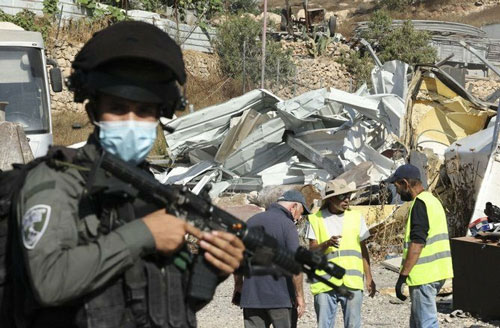Amman
A year before representatives of Israel and Palestine met at the White House on Sept. 13, 1993, and signed a framework for peace, Israeli authorities had confiscated 48 square kilometers of Palestinian land south of Bethlehem and converted it into a nature reserve.
The Israeli army has, 28 years later, renewed the confiscation order in a politicized decision carried out to block attempts to provide building permits to Palestinians who own private land in some of those areas.
Jad Isaac, director of the Applied Research Institute – Jerusalem, said a large part of those areas had been marked as Area C, meaning the Israelis had full control over who could build on them.
“Military order #51-21 of Nov. 18, 1992 has taken a large part of the areas east and south of Bethlehem, in the vicinity of the towns of Saer, Arab Al-Rashida and Shioukh,” he told Arab News.
Isaac said that Palestinians were not allowed to build on 29.7 square kilometers of the land despite them being listed as Area A, meaning local Palestinian municipalities had the right to make administrative decisions about them.
He said that 10.875 square kilometers of that land had been converted into nature reserves, blocking the rights of Palestinians in those areas.
Israeli authorities used the term nature reserve to block Palestinians from building on those areas so that, at an opportune time, they may be opened up for settlement expansion, he said.
Over the years the international community — especially the US — has been asking the Israelis to allow Palestinians to build in those areas.
Former mayor of Bethlehem Vera Baboun told Arab News the move was aimed at separating Bethlehem governorate from Hebron governorate.
The goal was to separate the populated Palestinian areas, as well as closing off areas to farming and grazing including blocking the ability of Palestinian farmers to reach their own land, while giving Jewish settlers the freedom to move around on Palestinian land, she added.
A Times of Israel report found that the Defense Ministry body responsible for authorizing construction in Area C had issued just a handful of building permits.
Plans for just 26 housing units were advanced in subcommittee meetings, with only six of those units — located in a single building — receiving actual building permits.
“Apparently, the security Cabinet’s decision that Netanyahu made sure to publicize as if Israel actually intended to approve any development for the millions of Palestinians in the occupied territories has turned out to be one big bluff, and even the few permits that were approved have not been issued,” HagitOfran, from the Peace Now settlement watchdog, told the newspaper.
Isaac said that, since 1967, Israel had used a variety of military orders to curtail Palestinian growth.
“They passed tens of laws that allow them to take away Palestinian land or prevent Palestinians from using it, while seeming to be doing all this under the pretext of democratic regulations.”
He said that, in addition to confiscating state land or land of absentee Palestinians, the favorite way of stunting Palestinian growth had been the conversion of large areas of Palestinian land into nature reserves.—Agencies










